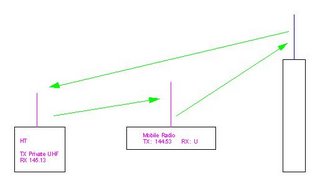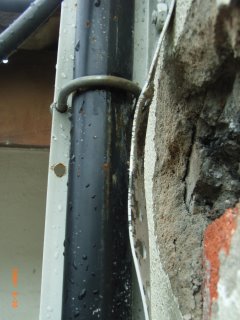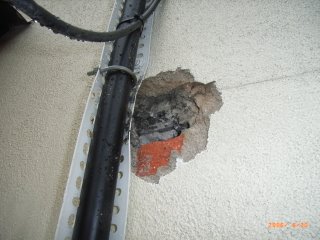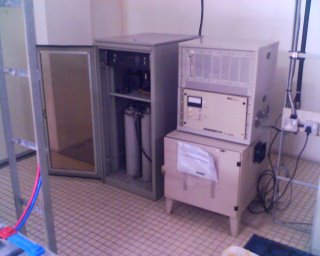Learn about Crossband Repeating
Adated from an article written by Christian KC0ARF
Crossband Repeating is a process where a Ham transmits one signal on one band (typically UHF), and it is received by another radio with a better antenna/power installation, and re-transmitted (typically on VHF) to another radio system, or a repeater.
When is it a good time to crossband repeat? Anytime that you are using an HT, and cannot be heard into the repeater system, or when you are working an extended event, and do not want to exhaust your HT's batteries.
Types of Crossbanding
There are two types of crossbanding- half duplex and full duplex. Full duplex means that the crossband repeater manages both "sides" of the conversation through to the repeater, whereas half duplex means that only your "side" of the conversation is re-transmitted.
Half Duplex
The easiest setup for crossband repeating is half duplex.

Using half duplex, the HT is set to transmit on a private UHF simplex frequency to the mobile radio. The mobile receives the signal, and re-transmits it into the repeater. When the HT is done transmitting, the mobile radio falls quiet, and the HT hears other people directly from the repeater.
How to setup this scenario:
* Setup your HT to transmit on UHF (let's say 446.00) Do not use that frequency... find your own!
* Setup your HT to receive on 145.13.
* Setup your mobile radio to transmit on 144.53, Do not, in this case, program in 145.13 with a (-) offset. You want the 144.53 simplex in the radio.
* Setup your mobile radio to receive on UHF simplex (our example, 446.00) .
* Place the mobile in crossband repeat. Check the power levels to ensure they are at minimal levels.
Full Duplex
Full duplex crossband repeating is more difficult to setup, but it does work. If your particular situation allows for half duplex, I strongly suggest that you proceed with that setup. Full duplex places many more demands on your crossband repeater, because it will be working almost 100 percent of the time. Remember, it re-transmits all of the data on the repeater, too! Only use this scenario if your HT is in a location that cannot hear the repeater directly, such as in your basement during severe weather.
Thanks to the contributer Christian KC0ARF
Crossband Repeating is a process where a Ham transmits one signal on one band (typically UHF), and it is received by another radio with a better antenna/power installation, and re-transmitted (typically on VHF) to another radio system, or a repeater.
When is it a good time to crossband repeat? Anytime that you are using an HT, and cannot be heard into the repeater system, or when you are working an extended event, and do not want to exhaust your HT's batteries.
Types of Crossbanding
There are two types of crossbanding- half duplex and full duplex. Full duplex means that the crossband repeater manages both "sides" of the conversation through to the repeater, whereas half duplex means that only your "side" of the conversation is re-transmitted.
Half Duplex
The easiest setup for crossband repeating is half duplex.

Using half duplex, the HT is set to transmit on a private UHF simplex frequency to the mobile radio. The mobile receives the signal, and re-transmits it into the repeater. When the HT is done transmitting, the mobile radio falls quiet, and the HT hears other people directly from the repeater.
How to setup this scenario:
* Setup your HT to transmit on UHF (let's say 446.00) Do not use that frequency... find your own!
* Setup your HT to receive on 145.13.
* Setup your mobile radio to transmit on 144.53, Do not, in this case, program in 145.13 with a (-) offset. You want the 144.53 simplex in the radio.
* Setup your mobile radio to receive on UHF simplex (our example, 446.00) .
* Place the mobile in crossband repeat. Check the power levels to ensure they are at minimal levels.
Full Duplex
Full duplex crossband repeating is more difficult to setup, but it does work. If your particular situation allows for half duplex, I strongly suggest that you proceed with that setup. Full duplex places many more demands on your crossband repeater, because it will be working almost 100 percent of the time. Remember, it re-transmits all of the data on the repeater, too! Only use this scenario if your HT is in a location that cannot hear the repeater directly, such as in your basement during severe weather.
Thanks to the contributer Christian KC0ARF










